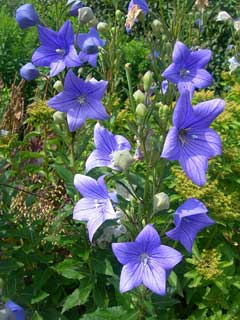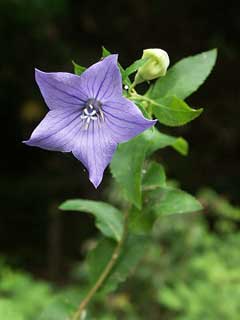 |
|
biolib.de |
 |
| http://commons.wikimedia.org/wiki/User:Cory |
Translate this page:
Summary
Bloom Color: Blue. Main Bloom Time: Late summer, Mid summer. Form: Upright or erect.
Physical Characteristics

 Platycodon is a PERENNIAL growing to 0.5 m (1ft 8in) by 0.4 m (1ft 4in) at a medium rate.
Platycodon is a PERENNIAL growing to 0.5 m (1ft 8in) by 0.4 m (1ft 4in) at a medium rate.
See above for USDA hardiness. It is hardy to UK zone 4 and is not frost tender. It is in flower from July to August, and the seeds ripen from August to September. The species is hermaphrodite (has both male and female organs).
Suitable for: light (sandy), medium (loamy) and heavy (clay) soils and prefers well-drained soil. Suitable pH: mildly acid, neutral and basic (mildly alkaline) soils. It can grow in semi-shade (light woodland) or no shade. It prefers moist soil.
UK Hardiness Map
US Hardiness Map
Synonyms
Campanula glauca. Thunb. C. grandiflora.
Plant Habitats
Edible Uses
Young leaves - cooked[177]. The radical leaves are said to be slightly toxic so only the top leaves should be used. Old leaves are powdered and used as a flavouring. Root - cooked[177]. Eaten in soups as a tonic vegetable[238]. It is also peeled and pickled or preserved in sugar[218]. A nutritional analysis is available[218].
References More on Edible Uses
| Composition
|
| Figures in grams (g) or miligrams (mg) per 100g of food.
|
|
|
Root (Dry weight)
|
|
- 379 Calories per 100g
- Water : 0%
- Protein: 3.2g; Fat: 1.2g; Carbohydrate: 93.7g; Fibre: 11.7g; Ash: 2g;
- Minerals - Calcium: 306mg; Phosphorus: 249mg; Iron: 8.2mg; Magnesium: 0mg; Sodium: 0mg; Potassium: 0mg; Zinc: 0mg;
- Vitamins - A: 0mg; Thiamine (B1): 0.13mg; Riboflavin (B2): 0.47mg; Niacin: 10.3mg; B6: 0mg; C: 0mg;
- Reference: [ 218]
- Notes:
|
|
Medicinal Uses
Plants For A Future can not take any responsibility for any adverse effects from the use of plants. Always seek advice from a professional before using a plant medicinally.
This species has a history of herbal use in China going back over 2,000 years and modern clinical tests have demonstrated its efficacy[218, 238]. It is widely used there in patent remedies and is also made into cough tablets[238]. The root contains saponins and is anthelmintic, antiasthmatic, anticholesterolemic, antiphlogistic, antitussive, astringent, carminative, expectorant, haemolytic, hypoglycaemic, sedative, stomachic, tonic and vermifuge. It lowers blood sugar and cholesterol levels in the liver and inhibits the release of histamine[116, 147, 174, 176, 178, 218, 238, 279]. It is used internally in the treatment of coughs with profuse phlegm, colds, bronchitis, pleurisy, pulmonary abscesses and throat infections[176, 238]. It is also used to treat hypertension and diabetes in Korea[279]. The root of plants 2 - 3 years old are harvested in the spring or autumn, peeled and used fresh or dried[238].
References More on Medicinal Uses
The Bookshop: Edible Plant Books
Our Latest books on Perennial Plants For Food Forests and Permaculture Gardens in paperback or digital formats.

Edible Tropical Plants
Food Forest Plants for Hotter Conditions: 250+ Plants For Tropical Food Forests & Permaculture Gardens.
More

Edible Temperate Plants
Plants for Your Food Forest: 500 Plants for Temperate Food Forests & Permaculture Gardens.
More

More Books
PFAF have eight books available in paperback and digital formats. Browse the shop for more information.
Shop Now
Other Uses
References More on Other Uses
Cultivation details
Landscape Uses:Border, Container, Rock garden, Specimen. An easily grown plant, it succeeds in any good well-drained garden soil but prefers a light more or less sandy soil in a sunny position or light dappled shade[200]. Plants are hardy to about -15°c[200]. Another report says it is hardy to -20°c[187]. A very ornamental and long-lived plant[1, 233], there are several named forms[238]. It is cultivated, especially in China, as a medicinal plant[61, 238]. This species has brittle roots and strongly resents root disturbance. It should be planted out in its permanent position as soon as possible, and preferably when dormant in the winter[111, 238]. Special Features:
Suitable for cut flowers. The plant is heat tolerant in zones 9 through 1. (Plant Hardiness Zones show how well plants withstand cold winter temperatures.
Plant Heat Zones show when plants would start suffering from the heat.
The Plant Heat Zone map is based on the number of "heat days" experienced in a given area where the temperature climbs to over 86 degrees F (30°C).
At this temperature, many plants begin to suffer physiological damage. Heat Zones range from 1 (no heat days) to 12 (210 or more heat days).
For example Heat Zone. 11-1 indicates that the plant is heat tolerant in zones 11 through 1.) For polyculture design as well as the above-ground architecture (form - tree, shrub etc. and size shown above) information on the habit and root pattern is also useful and given here if available. The plant growth habit is a clumper with limited spread [1-2]. The root pattern is a tap root similar to a carrot going directly down [1-2].
References Carbon Farming Information and Carbon Sequestration Information
Temperature Converter
Type a value in the Celsius field to convert the value to Fahrenheit:
Fahrenheit:
The PFAF Bookshop
Plants For A Future have a number of books available in paperback and digital form. Book titles include Edible Plants, Edible Perennials, Edible Trees,Edible Shrubs, Woodland Gardening, and Temperate Food Forest Plants. Our new book is Food Forest Plants For Hotter Conditions (Tropical and Sub-Tropical).
Shop Now
Plant Propagation
Seed - sow spring in a cold frame[111]. Free and quick germination[K]. Prick out the seedlings into individual pots when they are large enough to handle and plant them out in the winter when the plants are dormant[238, K]. Basal cuttings of non-flowering shoots in spring, preferably with a piece of root attached[188]. Harvest the shoots with plenty of underground stem when they are about 8 - 10cm above the ground. Pot them up into individual pots and keep them in light shade in a cold frame or greenhouse until they are rooting well. Plant them out in the summer.
Other Names
If available other names are mentioned here
Native Range
TEMPERATE ASIA: Amur, Anhui Sheng, China, Eastern Siberia, Fujian Sheng, Guangdong Sheng, Guangxi Zhuangzu Zizhiqu (north), Guizhou Sheng, Hebei Sheng, Heilongjiang Sheng, Henan Sheng, Hokkaidô, Honshu, Hubei Sheng, Hunan Sheng, Japan, Jiangsu Sheng, Jiangxi Sheng, Jilin Sheng, Korea, Kyushu, Liaoning Sheng, Magadanskaja oblast, Nei Mongol Zizhiqu, Primorye, Russian Federation, Ryukyu Islands, Shaanxi Sheng, Shandong Sheng, Shanxi Sheng, Shikoku, Sichuan Sheng (east), Yunnan Sheng (southeast), Zhejiang Sheng,Russian Federation-Eastern Siberia.
Weed Potential
Right plant wrong place. We are currently updating this section.
Please note that a plant may be invasive in one area but may not in your area so it's worth checking.
Conservation Status
IUCN Red List of Threatened Plants Status :

Growth: S = slow M = medium F = fast. Soil: L = light (sandy) M = medium H = heavy (clay). pH: A = acid N = neutral B = basic (alkaline). Shade: F = full shade S = semi-shade N = no shade. Moisture: D = dry M = Moist We = wet Wa = water.
Now available:
Food Forest Plants for Mediterranean Conditions
350+ Perennial Plants For Mediterranean and Drier Food Forests and Permaculture Gardens.
[Paperback and eBook]
This is the third in Plants For A Future's series of plant guides for food forests tailored to
specific climate zones. Following volumes on temperate and tropical ecosystems, this book focuses
on species suited to Mediterranean conditions—regions with hot, dry summers and cool, wet winters,
often facing the added challenge of climate change.
Read More
Expert comment
Author
(Jacq.)A.DC.
Botanical References
58200
Links / References
For a list of references used on this page please go here
Readers comment
| Add a comment |
|
If you have important information about this plant that may help other users please add a comment or link below. Only comments or links that are felt to be directly relevant to a plant will be included. If you think a comment/link or information contained on this page is inaccurate or misleading we would welcome your feedback at [email protected]. If you have questions about a plant please use the Forum on this website as we do not have the resources to answer questions ourselves.
* Please note: the comments by website users are not necessarily those held by PFAF and may give misleading or inaccurate information.
To leave a comment please Register or login here All comments need to be approved so will not appear immediately.
|
|